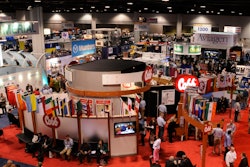The purpose of every corporate mission statement is define the reason the organization exists and provide a framework for how it conducts business now and in the future; however, how firmly — and creatively — it sticks to this path is another story.
From the top down, United Farmers Cooperative (UFC), a farmer-owned co-op operating in southern Minnesota, keeps true to it’s promise to member owners: “To provide, products, services and technology in a manner extraordinary enough to add value to people’s lives.”
It’s dedication to making decisions that affirm this position translates to it’s dedication to customer service, the hiring of well-trained employees and it’s ability to rollout new offerings, i.e. insurance and financial services.
“Sure, at the end of the day we’re moving commodities, selling fertilizer, buying grain — it’s not fancy stuff — but it’s important stuff and it holds these communities together,” explains UFC’s CEO Jeff Nielsen.
Also aligning with the goals outlined in mantra, the cooperative’s latest innovation, the creation of United Grain Systems (UGS), a 50/50 joint venture between UFC and Archer Daniels Midland (ADM), grew out of the willingness for both entities to think outside of the box.
“The genesis of the UGS has always been about how [UFC] can provide access to global markets for our local producers,” says Nielsen, who also serves as UGS’s general manager. “We had to step up and do that to remain competitive and to deliver the best value and opportunities for our producers.”
While UGS absorbed UFC’s existing grain division and five country elevators, this new business entity is hallmarked by a new 7-million-bushel, high-speed, high-volume shuttle loading facility in Brownton, MN.
The story of this collaboration begins a decade ago at the cornstalk-laden fields surrounding the intersection of the highways MN 15 and U.S. Route 212.
Field Of Dreams
Nielsen, who grew up on a farm in rural Wisconsin and has worked for various agribusiness professionally before joining UFC in 1995, credits having a life-long connection to agriculture for giving him “the opportunity to see how many things are done in many different way” and thereby expanding his approach to having a solutions-based mindset.
“During my first 10 years with the cooperative, we focused on making sure we were world class in whatever we did by investing in our facilities — such as our feed mills, fertilizer plants and an adjusted energy division,” he explains.
Meanwhile, as the yields and volume increased year over year, growth of the co-op’s grain division happened organically. For example, in 2009 UFC’s five elevators handled roughly 6 million bushels; in 2011, it grew to over 18 million bushels.
“While our feed business is robust, it wouldn’t grow at a pace to consume all the additional grain volume,” explains Nielsen.
Logistics and storage began to pose a problem for the co-op — and the volume wasn’t going to let up.
“At the time, we were trucking grain to a neighboring co-op to the south to be loaded on to unit trains or Savage on the river — which obviously inefficient,” he recalls. “It was clear the cooperative needed to make significant investments in its grain operation.”
At a board meeting in 2009 expansion of UFC’s Winthrop elevator was on the table, when a board member suggested that perhaps investing in a landlocked site without rail access might not be the best use of the co-op’s resources.
“One director said, ‘Would this expansion enhance our ability to serve?’ Since it wouldn’t provide access to global markets, we decided to take a different direction,” Nielsen recounts. “He turned to me and said, ‘Jeff, what do you think we should do?’ I looked at them and said, ‘Well, I have an idea…’”
Nielsen, who was once a Land O’ Lakes sales manager and often found himself at the aforementioned intersection of 212 and 15, had made a mental note about a particular plot of land on the [north/east] side of the crossing; and he seized this opportunity to recommend it.
“I had been driving past this corner for many years and it just seemed like a logical location because of it’s proximity to the rail and access to these main thoroughfares,” Nielsen says. “I suggested we look at it and take a quantum leap. From there, the conversation shifted from a $4 million expansion toward a $30 million state-of-the-art project with rail access.”
Planning pays off
While Nielsen had been eyeing the 200-acre plot of land for nearly a decade, UFC spent two years working to purchase the holding from its previous owners before it actually had the option to buy.
“The landowners saw the value in what we were trying to do so the project was really helped along with their cooperation,” Nielsen explains. Once the property was secured, the co-op prepared to begin negotiations with railroads.
It was obvious whatever direction the new facility would take it was crucial for the investment to leverage access to secure marketing opportunities now and in the future, Nielsen says. Accessing global markets was only half the challenge because as the scope of the Brownton project continued to grow so did its price tag.
The solution to both challenges: Find a partner who could mitigate the risk and cover the cooperative’s logistical and merchandising shortcomings.
“Before we sat down with the major grain houses, it was important to show we were serious and we had done our homework,” Nielsen says.
From the inception of its plan to “go big,” UFC had two objectives: To be relevant long-term and to build the facility right. To aid in the strategic planning process, it hired Dr. Bill Wilson, a professor at North Dakota State University who consults on grain marketing, transportation and logistics, to create a “draw analysis” of grain flow patterns. The objective of the study was to make the case for the demand for and the strength of a facility of this scale in South Central Minnesota.
Traditionally much of the market and surplus grain was being trafficked through Savage, a supply chain solutions company with a barge loading facility on the Mississippi in [City], MN. Wilson’s study found that while the Savage site will always be important in accessing markets, it has grown less relevant in recent years.
Nielsen explains: “In my tenure, corn used to be sent to Savage to travel down the river and fertilizer would come back up — the barges were always full both ways. Now, however, with the need to get fertilizer in the ground so quickly in the spring, more and more large scale hub plant facilities have been built to receive fertilizer by rail. If the fertilizer isn’t coming up in the barges, it makes freight more expensive to go down with grain — combined with significant short comings in the upper Mississippi locks and dams system… The draw analysis really brought out these trends and proved that they happening and will continue to happen.”
Once the validity of the location was backed by thorough research and favorable market conditions, UFC used Wilson’s findings to create a firm business plan to shop around to the seven major multinational grain houses
NURTURING A PARTNERSHIP
“We took our findings and a proposal out to the industry, explained that we had a way to originate the grain; we know there is a demand for this — help us get to the best markets in the world,” Nielsen says, crediting the board of directors with its openness in looking for a sophisticated business partner. “We spoke to every major grain player in the upper Midwest, and the board tried to determine what the best route would be: do we choose a partner or to try to go it alone?”
During the year-and-a-half-long process, it chose ADM, and formed United Grain System, a 50/50 partnership owned by UFC and ADM.
“We’ve been working with ADM for a year, people wondered if we could co-exist with a major global partner like ADM, it’s been an outstanding partnership,” Nielsen says. “ADM has partners and customers around the world who need the grain we grow in Minnesota.”
“We’ve been able to focus on what we can do well, which is working with producers to provide the best local service; and ADM has brought an outstanding understanding of infrastructure and experience to deliver the grain to global markets. At the end of the day, that’s been a great combination.”
UFC/ADM chose to build on a Greenfield site because of unlimited expansion capabilities. UFC broke ground in September of 2011; about a year later the facility opened for business just in time for the 2012 harvest.
ABOUT THE TERMINAL
UGS is a combination between the Brownton shuttle facility and five elevators, which were originally part of UFC’s grain division and are located in a spoke fashion around the terminal. In total, UGS has a storage capacity of 8 million bushels.
The Brownton facility has 7 million bushels of on-hand storage capacity, including piles: a 2.8 million upright (550,000-bushel slip concrete work house with 420,000-bushel bins and nine interstice bins in between), 1.5 million pile with reclaim and a 3 million bushel traditional pile that is mechanically filled and tarped. On either side of the center facility are two GSI 550,000-bushel steel bins. Reclaim under bins are 50,000-bushel/hour Hi-Roller conveyors that come to the center receiving area.
As producers approaching the site, they enter the scale house at the inbound scale, which can hold 40 to 50 trucks if necessary. USG uses an automated card reader system to scan the card, which records customer and truck information, and generates a scale ticket [what’s on the ticket]. Once this information is gathered, the truck’s load is probed and a grain sample is delivered to the office for grading. While the truck is being staged off the scale, the operator is next truck is being processed, maintaining a constant flow of vehicles.
After the grain is graded, the truck is sent to one of three pits utilizing three 20,000-bushel/hour receiving pits, each receiving lane with 11,000-bushel pits, 20,000-bushel reclaim and individual 20,000-bushel legs.
Once a truck arrives at the pit, the operators in the control room refer to the computer to know where the grain is supposed to go in the facility and set it up as quickly as possible to the correct bin. As soon as the truck arrives at the correct pit, it is dumped and the grain is taken away and the pit is ready to receive the next truck. As soon as it’s done dumping, the truck comes around to the outbound scale, uses the card to scan out, an end weight is captured and a ticket is automatically generated without the customer ever having to enter the office.
“It’s about speed, space and velocity to move grain and that’s the key draw,” Nielsen explains. “Here in Minnesota, harvest is crunch time — the window of time the weather cooperates varies —and when it’s time to pull the crop out of the field, the farmers are ready to roll. It’s weird to have your patrons thank you for doing it right.”
Tews points to the site’s use of redundancy built into the elevator as another efficiency: “If a piece of equipment goes down, the customers in the truck line wouldn’t notice because we could switch the grain flow around in the elevator and move stuff around as needed to get grain back into the facility quickly while we work on the problem equipment. If the shipping leg were ever to go down, again, we have the redundancy built in where our receiving legs and also our wet and dry legs for our dryer can hit our shipping bin and we are able to continue loading shuttle trains efficiently.”
The entire facility is built on a tunnel system for ease of cleaning, maintenance and keeping equipment out of the elements.
The average ticket time from punch in, dump and punch out is somewhere around five minutes; it can easily handle 500 trucks a day with very minimal waiting.
USG has the ability to load 110-car shuttle trains connected on to the TCW short line, accessing the Union Pacific (UP), Burlington Northern Santa Fe (BNSF) and Canadian Pacific (CP) railroads.
Shuttles coming into the facility can be loaded in 7 to 7.5 hours with 440,000 bushels of grain. Tackling the growing pains, the first train took 16 hours, but by the third train, the UGS team was able to load it in a little over 6.5 hours.
“During harvest, the shuttle loading capability allowed UGS to turn bins and open space to keep customer trucks coming,” Nielsen says.
SUCCESSFUL INVESTMENT
While the inclement weather of the 2012 growing season— specifically hail and drought —presented a mixed bag of haves and have nots at harvest, UGS exceeded even the best of expectations right off the bat.
“We’ve received more grain in the first four months of operation than we dumped the entire 12 months prior in the UFC system. We’ve been extremely pleased with the response to the facility; we’ve added 460 new patron accounts. These are producers who have never done business with our cooperative before — and it’s been here since 1916.”
UGS also underestimated the demand for that grain as well.
“We felt that if we could continue to load 30 to 40 trains by the third or fourth year of the project, we’d be ecstatic; we hoped to load 20 in the first year; but, here we are four months into it and we already have 18 sold so we think we’ll easily surpass our original projections,” Nielsen explains.
UGS is on pace to handle 30 million bushels in 2013.
UFC adopted the motto: “People, Pride and Purpose Since 1916.” In line with this statement, Nielsen credits his staff with making UGS a success: "You can have the best facility in the world, but it means nothing if you don’t have the right people in place. We hire the best talent and give them the best tools to do their job."
“UGS has been receiving a lot of positive feedback,” Tews explains. “We’re providing exactly what the customer needs: securing better prices and, in turn, giving back to producers. Not just a place to deliver grain, smiling face, making it more personal than being a large business. Producers are the No. 1 priority – making them feel welcome and let them know we appreciate their business.”


















